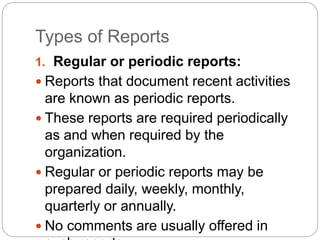Report writing and types
- 2. Writing Reports A report is a statement of the results of investigation on which information is required. A report is a ‘structured written document’ in which a specific issue is examined for the purpose of conveying information in order to report findings, to answer a request, to put forward ideas and make
- 3. Types of Reports 1. Regular or periodic reports 2. Informational report 3. Analytical report 4. Research report 5. Special report
- 4. Types of Reports 1. Regular or periodic reports: Reports that document recent activities are known as periodic reports. These reports are required periodically as and when required by the organization. Regular or periodic reports may be prepared daily, weekly, monthly, quarterly or annually. No comments are usually offered in
- 5. Types of Reports 2. Informational report: Is used to present detailed facts about a given activity without any note or suggestion. 3. Analytical report: It contain facts along with analytical explanations offered by the reporter. Such reports contain the narration of facts, collected data and information, followed by the conclusions or interpretations of the collected data.
- 6. Types of Reports 4. Research report: A research report is based on some research work on a given problem. The report will not only focus on findings but also offer suggestions. 5. Special report: These reports are prepared to meet specific needs for writers and readers. For some readers who want to decide on a course of action, these reports provide them the information that may help in their decision-
- 7. Formats of Reports 1. Long informal/semi-formal report: They are more detailed , structured and have more sections than the short report, comprising the title page, summary, introduction, body of the report (findings and discussions), conclusions and recommendations, and appendices. 2. Formal report: These are written only for inter organizational purposes. They are written for a large audience. They are most structured and have more sections, such as title page, summary, table of contents, table of illustrations, figures, tables (if any), introduction, body of the report (methodology, findings and discussion), conclusions, recommendations, bibliography and appendices (if applicable). Third person and passive voice should be used. Such as ‘it is recommended…..’ rather than ‘ I have recommended…’
- 8. Parts of a Report Prefatory part 1.Title page 2. Acknowledgement 3. Table of contents 4. Abstract or executive summary Main body 1. introduction: General view of your material, avoid details. Clearly mention the problem or issue. Purpose (why is the report being written?)
- 9. Parts of a Report Background information. Scope (what kind of information will be presented? What will be excluded? Don’t forget to give the definitions of technical terms. 2. Literature review: 3. Methodology: How you carried out your research/data collection for the report. Did you carry out interviews or questionnaires. What statistical tools did you use?
- 10. Parts of a Report 4. Limitations: Mention the issue that came in the way of making your report 100 percent accurate. 5. Results/findings: Present your findings in a simple way. There are number of ways in which results can be presented such as making use of tables, graphs, pie charts, bar charts etc. 6. Discussion: This is the section where you can analyze and interpret your results drawing from the information which you have collected, explaining its significance.
- 11. Parts of a Report Identify important issues and suggest explanations for your findings. 7. Conclusion: It is a summary of your study-its overall purposr, its overall findings 8. Recommendations:
Editor's Notes
- Of










